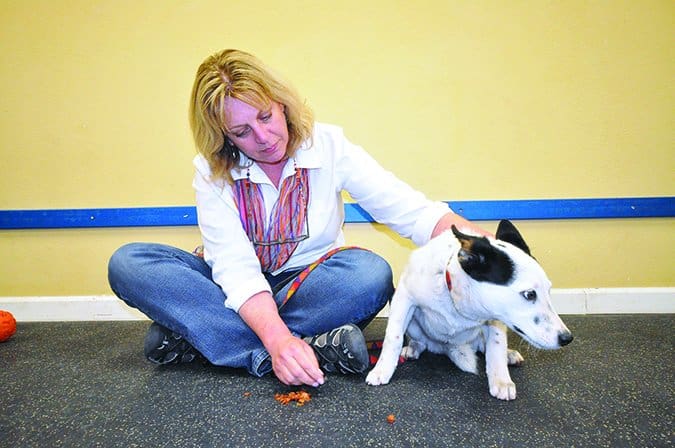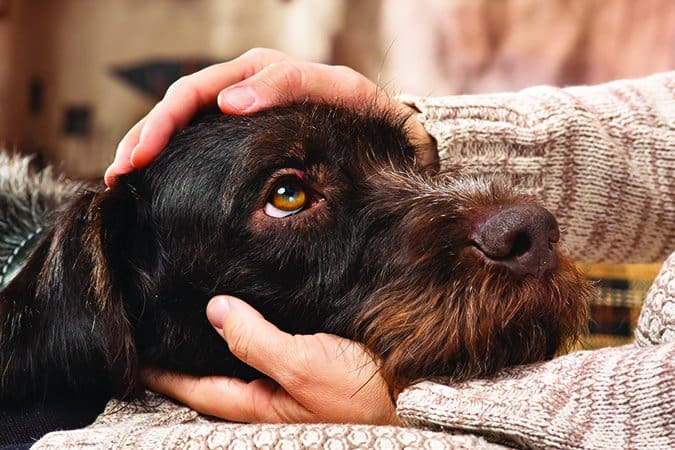Like many dog training schools, at my school, AutumnGold Dog Training Center, we include an orientation night each session. Owners attend that session without their dogs to learn about our training philosophy and methods. Because it is not unusual for young dogs to react with a bit of anxiety on the first night of class, we teach students how to reduce their dogs’ stress and provide methods for helping dogs to feel secure and safe during class.
Recently, one of my students asked, “Should I comfort my dog when we arrive at class? I have been told that I should not pet or speak softly to my dog if he is upset or anxious because that will reward his fear. Is this true?”
I typically answer this question with a parable about clowns.
I am petrified of clowns, like most rational adult humans (right?!). Everything about them is creepy to me – their red bulbous noses, crazy orange hair, ridiculous cartoon-sized shoes – all of it!
So, let’s imagine that my front doorbell rings and outside is the guy pictured above, grinning and giving me two big thumbs-up. Responding to my shrieks, my husband Mike comes running and attempts to calm me. (In reality, Mike would be bolting out of the back door with the dogs, yelling “Save Yourself”!)
For the sake of my anecdote, let’s say he’s hanging tough and comforting me.
Would Mike’s comfort cause my clown fear to increase? Of course not! Nothing can make me more fearful of clowns! Instead, it’s reasonable to assume that having someone talk to me calmly, explaining to me that clowns are not dangerous (yeah, right!) will reduce my anxiety.
Can We Reinforce Fear?
There is absolutely no evidence, not one bit, suggesting that providing comfort and security to a distressed dog causes the dog’s anxiety or fear to increase. Why then, does this myth persist among dog owners and even with some trainers? Why are owners still advised to ignore their dog when he is distressed or anxious or fearful, as if providing any attention to the dog will reinforce those emotions? I suspect that it has to do with confusion about the difference between an emotional response (which is under very little conscious control) and a learned (operant) response (which is under varying degrees of conscious control).
Lessons from Learning Theory
A learning theory clears up this confusion for us. Stress, anxiety, and fear are emotional responses. We do not choose to be anxious or fearful; we actually have very little control over these responses.
Conversely, any behaviors that someone uses to successfully escape or avoid fear-inducing situations are operant; we have some control over these. If these behaviors are successful – in that they lead to a reduction in anxiety and fear – they will indeed be reinforced. This is called avoidance learning and happens when fleeing a fear-producing experience results in a reduction of fear.
For example, if I ran away from the clown at my door, I would experience relief from my fear. (Assuming, of course, that the clown was not chasing me, as I am certain they do.) Because the strategy of running away was successful in reducing my fear and keeping me safe, I would, in all likelihood, repeat this tactic if I once again found a clown at the door. In this example, we say that “the behavior of running away from clowns has been negatively reinforced.”
Dogs, of course, also learn this way. For example, a dog who is nervous around unfamiliar people may hide behind the couch whenever someone new enters her home. The behavior of hiding is negatively reinforced each time that the dog uses it as a strategy, because hiding allows the dog to avoid exposure to new people and results in an abatement of her fear. Unfortunately, this becomes a double-edged sword – if the dog preemptively hides each time that she hears someone at the door, she never has the opportunity to learn that visitors are not actually harmful (more about this later).
Avoidance learning is not the same as “reinforcing fear.” It’s important to remember that anxiety and stress and fear are basic emotional responses that are involuntary and have important biological functions. Our dogs do not choose to be anxious or fearful. These are reactions to situations that a dog perceives to be unfamiliar or threatening. It is false to state that a dog chooses or willingly decides to experience fear. However, this is exactly what is implied when owners are advised to ignore their dog when he is anxious or fearful due to the erroneous belief that comforting will reinforce the dog’s fear. It just ain’t so.

Providing Comfort
Should we comfort our dogs when they are nervous? Okay, if we accept that providing comfort and care to a distressed dog does not reinforce fear, do we know whether or not providing comfort in the form of petting and speaking softly to our dogs helps to reduce their anxiety? Although it certainly feels like it should, do we have evidence that supports or refutes this?
Although still limited in scope, there is a growing body of research that addresses this question. For example, last year, a group of researchers in France reported that dogs who were examined in a veterinary setting with their owner present and comforting them demonstrated reduced signs of stress when compared with dogs who were examined with the owner seated away from them.
Recently, another study conducted by Chiara Mariti’s research team at the University of Pisa in Italy, examined the effects of gentle petting upon a dog’s stress level during a subsequent period of separation. Here is what they found:
The Italian Study on Effects of Petting Stressed Dogs
The study included a group of 10 dogs and their owners. Each dog was tested in two conditions while visiting a training center that was unfamiliar to the dog and owner. In the “petting” condition, the owner gently petted their dog for a period of one minute, while talking to a friendly stranger. In the “no petting” scenario, the owner talked to the stranger without petting their dog.
In both settings, the dog’s leash was then handed to the stranger and the owner left the area and remained out of sight for three minutes. The researchers video recorded each test and measured the dogs’ heart rates, salivary cortisol levels, and behaviors before, during, and after separation.
Study Results
Although the differences between the two groups were not dramatic, the researchers did report a few interesting findings:
Heart rate: When dogs were not petted by the owners prior to separation, their heart rates did not change. Conversely, when they were petted prior to separation, heart rates decreased (difference approached statistical significance; P = 0.07). This result suggests that petting either prevented or reduced the stress response associated with separation of the dog from the owner.
Calm behaviors: The petting scenario resulted in significantly longer periods of calm behaviors exhibited by the dogs while they were separated from their owner, compared to the no petting scenario (38 seconds versus 11 seconds of calm behavior, respectively).
Overall, not highly stressed: In general, the dogs in both conditions displayed mild behavioral signs of stress, some vocalizations, and oriented toward the area that the owner exited. However, these signs were not severe and salivary cortisol levels after separation were not elevated, suggesting that the level of stress induced by this test was relatively low.

© Pavel Rodimov | Dreamstime.com
Conclusions on Comforting Nervous Dogs
The results of this pilot study suggest that, when dogs are subjected to a mildly stressful situation such as a short separation from their owner, gentle petting prior to the separation can promote reduced feelings of stress and calmer behaviors. While this is not earth-shattering stuff, it is a nice bit of evidence showing that providing comfort and a secure base to our dogs is a good thing and not something to be discouraged.
The moral of the story? If we believe that comforting a loved one when they are distressed is the right thing to do (i.e., we should comfort those who we love), why would we not consider this to be an appropriate approach with our dogs? Fear/anxiety is not a choice. The caring (and effective) approach to dealing with a dog’s anxious response is to calmly and quietly come to the dog’s aid and remove him from the anxiety-provoking situation.
In our training classes, we quickly move dogs who appear stressed to a quiet corner or behind a set of visual barriers. We teach owners how to “body block” so that they act as their dog’s safe base. We encourage owners to sit on the floor and allow their dog to lie close or in their lap (size permitting) as the dog gradually acclimates to the new setting and commotion of class.
In some cases, we may partition off a small section of the training floor with gates. We find that this often allows timid dogs to be introduced to the class once they are comfortable and happy.
It is the responsibility of each of us, as our dogs’ caretakers, to protect them from excessively stressful and frightening situations. Simply ignoring a dog’s stress in a misguided attempt to change behavior is counter-intuitive to most owners who love their dogs – as it should be. Not only does comfort not reinforce fear, we have evidence that our dogs benefit from our comfort and support by showing reductions in stress and anxiety. Be there for your dog, always.
And remember, a fear of clowns is real. If you see a clown coming my way, don’t get between me and the door!
Cited Study
Mariti C, Carlone B, Protti M, Diverio S, Gazzano A. “Effects of petting before a brief separation from the owner on dog behavior and physiology: A pilot study.” Journal of Veterinary Behavior 2018; 27:41-46.






